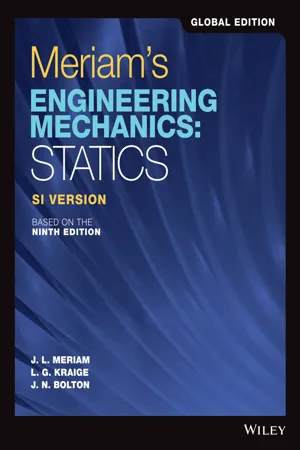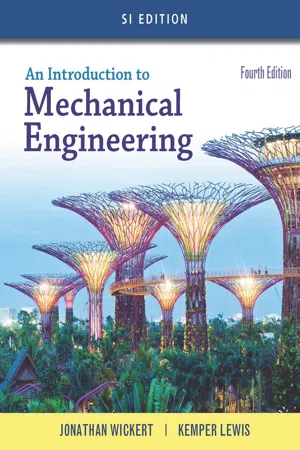Technology & Engineering
Two Force and Three Force Members
Two force and three force members are concepts used in engineering to analyze the forces acting on a structure. A two force member is a structural component subjected to only two forces, while a three force member is subjected to three forces. Understanding these concepts is important for designing and analyzing the stability and strength of structures.
Written by Perlego with AI-assistance
Related key terms
1 of 5
3 Key excerpts on "Two Force and Three Force Members"
- eBook - PDF
- James L. Meriam, L. G. Kraige, J. N. Bolton(Authors)
- 2020(Publication Date)
- Wiley(Publisher)
CHAPTER 2 Force Systems 2/1 Introduction In this and the following chapters, we study the effects of forces which act on engi- neering structures and mechanisms. The experience gained here will help you in the study of mechanics and in other subjects such as stress analysis, design of structures and machines, and fluid flow. This chapter lays the foundation for a basic understanding not only of statics but also of the entire subject of mechanics, and you should master this material thoroughly. 2/2 Force Before dealing with a group or system of forces, it is necessary to examine the properties of a single force in some detail. A force has been defined in Chapter 1 as an action of one body on another. In dynamics we will see that a force is de- fined as an action which tends to cause acceleration of a body. A force is a vector quantity, because its effect depends on the direction as well as on the magnitude of the action. Thus, forces may be combined according to the parallelogram law of vector addition. CHAPTER OUTLINE 2/1 Introduction 2/2 Force SECTION A Two-Dimensional Force Systems 2/3 Rectangular Components 2/4 Moment 2/5 Couple 2/6 Resultants SECTION B Three-Dimensional Force Systems 2/7 Rectangular Components 2/8 Moment and Couple 2/9 Resultants 2/10 Chapter Review The properties of force systems must be thor- oughly understood by the engineers who design structures such as these overhead cranes. Anze Bizjan/Shutterstock 17 18 CHAPTER 2 Force Systems The action of the cable tension on the bracket in Fig. 2/1a is represented in the side view, Fig. 2/1b, by the force vector P of magnitude P. The effect of this action on the bracket depends on P, the angle , and the location of the point of application A. Changing any one of these three specifications will alter the ef- fect on the bracket, such as the force in one of the bolts which secure the bracket to the base, or the internal force and deforma- tion in the material of the bracket at any point. - Jonathan Wickert, Jonathan Wickert, Kemper Lewis(Authors)
- 2016(Publication Date)
- Cengage Learning EMEA(Publisher)
This relationship can be expressed as F = ma. 3. The forces of action and reaction between two objectives are equal, opposite, and collinear. Element 3: Forces in structures and machines Copyright 201 Cengage Learning. All Rights Reserved. May not be copied, scanned, or duplicated, in whole or in part. Due to electronic rights, some third party content may be suppressed from the eBook and/or eChapter(s). Editorial review has deemed that any suppressed content does not materially affect the overall learning experience. Cengage Learning reserves the right to remove additional content at any time if subsequent rights restrictions require it. 4.1 Overview 113 In this and the following chapters, we will explore these principles of forces and the problem-solving skills that are needed to understand their effects on engineering hardware. After developing the concepts of force systems, moments, and static equilibrium, you will see how to calculate the magnitudes and directions of forces acting on and within simple structures and machines. In short, the process of analyzing forces is a first step taken by engineers to see whether a certain piece of hardware will operate reliably (Figure 4.1). A second objective of this chapter is for you to start understanding the inner workings of mechanical hardware, beginning with rolling element bearings. Just as an electrical engineer might select off-the-shelf resistors, capacitors, and transistors as the elements of a circuit, mechanical engineers have good intuition for specifying bearings, shafts, gears, belts, and other machine components. A working knowledge of hardware and machine components is important for you to develop a technical vocabulary. Mechanical engineering has its own precise language, and, to communicate effectively with other engineers, you will need to learn, adopt, and share that language.- Jonathan Wickert, Kemper Lewis, Jonathan Wickert(Authors)
- 2020(Publication Date)
- Cengage Learning EMEA(Publisher)
This relationship can be expressed as F = ma. 3. The forces of action and reaction between two objectives are equal, opposite, and collinear. Element 3: Forces in structures and machines Copyright 2021 Cengage Learning. All Rights Reserved. May not be copied, scanned, or duplicated, in whole or in part. Due to electronic rights, some third party content may be suppressed from the eBook and/or eChapter(s). Editorial review has deemed that any suppressed content does not materially affect the overall learning experience. Cengage Learning reserves the right to remove additional content at any time if subsequent rights restrictions require it. 4.1 Overview 113 In this and the following chapters, we will explore these principles of forces and the problem-solving skills that are needed to understand their effects on engineering hardware. After developing the concepts of force systems, moments, and static equilibrium, you will see how to calculate the magnitudes and directions of forces acting on and within simple structures and machines. In short, the process of analyzing forces is a first step taken by engineers to see whether a certain piece of hardware will operate reliably (Figure 4.1). A second objective of this chapter is for you to start understanding the inner workings of mechanical hardware, beginning with rolling element bearings. Just as an electrical engineer might select off-the-shelf resistors, capacitors, and transistors as the elements of a circuit, mechanical engineers have good intuition for specifying bearings, shafts, gears, belts, and other machine components. A working knowledge of hardware and machine components is important for you to develop a technical vocabulary. Mechanical engineering has its own precise language, and, to communicate effectively with other engineers, you will need to learn, adopt, and share that language.
Index pages curate the most relevant extracts from our library of academic textbooks. They’ve been created using an in-house natural language model (NLM), each adding context and meaning to key research topics.


